The Role of Supervisor-Led Safety Observations in Workplace Safety
Workplace safety is more than just a checklist; it's a culture that demands daily attention, collaboration, and continuous improvement. One powerful method companies are now embracing is supervisor-led safety observations—a proactive approach where supervisors directly observe workers, identify unsafe behaviors or hazards, and take corrective action before an incident occurs.
In this article, we’ll explore the critical role supervisors play in promoting safety, how to implement observation programs effectively, and why this strategy matters for creating a truly safe work environment.
Understanding Workplace Hazards and Supervisor Responsibilities
From slips and falls to hazardous material exposure, the modern workplace is full of potential risks. According to OSHA, thousands of preventable workplace injuries occur annually due to unsafe behaviors, equipment misuse, or environmental hazards.
That’s where supervisor-led safety observations come in. These observations are designed to identify potential hazards before they lead to accidents. Supervisors not only watch for unsafe actions but also coach workers on safe practices, reinforcing the importance of vigilance on the job.
Building a Safety-First Culture Through Leadership
At the end of the day, safety culture is shaped by leadership. If supervisors model safe behavior, give respectful feedback, and actively support their teams, others will follow. It’s that simple—and that powerful.
Supervisor-led safety observations and advanced training programs such as the OSHA 30-Hour Construction Training helps companies shift from reactive to proactive safety practices.
What Are Supervisor-Led Safety Observations?
Simply put, supervisor-led observations involve supervisors actively monitoring and evaluating workers’ actions on the job. Unlike traditional safety audits, these observations are informal, frequent, and designed to:
- Identify risky behaviors or unsafe conditions
- Offer immediate, constructive feedback
- Encourage employee involvement in safety culture
- Reinforce proper procedures and PPE usage
These observations are not about punishment—they’re about learning, improving, and protecting lives.
Why Are They Important?
Let’s imagine a scenario.
John, a supervisor at a busy construction site, notices a worker climbing a ladder without three points of contact. Instead of writing a violation report, John pauses, approaches the worker, and calmly explains the importance of ladder safety. The worker nods, adjusts his posture, and continues safely. That small intervention could prevent a life-threatening fall.
Supervisor-led observations are the first line of defense against injury. Here’s why they matter:
- Provide real-time, on-the-spot coaching
- Build trust between management and workers
- Identify patterns of unsafe behavior early
- Support a culture of accountability
Step-by-Step Guide to Implementing a Supervisor-Led Observation Program
Want to get started with your own safety observation program? Here’s a clear and simple step-by-step guide:
Step 1: Train Your Supervisors
Ensure supervisors are trained not only in technical safety protocols but also in soft skills like communication and observation. Consider enrolling them in a reputable OSHA Training Course to boost their safety IQ.
Step 2: Set Clear Goals
What do you want to achieve? Fewer back injuries? Reduced slip incidents? Be specific. For example: “Decrease ladder-related near misses by 30% in 3 months.”
Step 3: Develop Observation Checklists
Create practical observation forms or checklists tailored to your industry. Focus on:
- PPE compliance
- Machine handling
- Housekeeping
- Ergonomic risks
Step 4: Observe and Document
Encourage supervisors to conduct observations regularly. They should:
- Watch without interfering unless immediate danger is present
- Record both safe and unsafe practices
- Note the time, task, and worker behavior
Step 5: Provide Immediate Feedback
This is where real change happens. Feedback should be:
- Respectful and encouraging
- Focused on behavior, not personality
- Supported by reasoning (e.g., “Wearing goggles protects your eyes from flying debris.”)
Step 6: Analyze the Data
Aggregate observation data to identify trends or common hazards. This helps safety teams make informed decisions and target problem areas before they escalate.
Step 7: Reward Safe Behavior
Recognize workers who demonstrate excellent safety practices. This builds morale and reinforces the value of doing things the right way.
Common Mistakes to Avoid
Even the best programs can falter if not executed thoughtfully. Watch out for these pitfalls:
- Using observations to “catch” workers doing wrong—this creates fear
- Failing to follow up on identified issues
- Infrequent observations that don’t drive real change
- Not involving frontline employees in safety planning
A true safety culture is built on respect, transparency, and continuous dialogue—not blame or box-ticking.
Real-World Anecdote: From Near Miss to Mindset Shift
Take the story of Lila, a warehouse supervisor. During an observation, she spotted a forklift operator reversing without honking. She gently pulled him aside, reminded him of the rule, and asked him why he skipped it. He said he “didn’t think anyone was nearby.”
Rather than scolding him, Lila shared a story of another site where a similar situation led to injury. That moment changed his mindset. Now, he honks before every reverse and reminds others to do the same. All thanks to a conversation rooted in empathy.
The Psychological Edge: Safety as a Team Sport
One of the best-kept secrets of supervisor-led observations is their effect on workplace psychology. Workers feel seen, heard, and valued when supervisors are present and engaged. It reinforces the idea that safety isn’t just management’s responsibility—it’s everyone’s job.
A strong observation program also fosters peer-to-peer accountability. Workers begin to look out for one another, creating a collective safety net far stronger than any single policy.
Read more about enhancing supervisor safety practices with the OSHA Training Course.
Final Thoughts
In high-risk environments, every small action matters. A single observation could prevent a serious injury or even save a life. By empowering supervisors to lead with vigilance and empathy, companies can drastically reduce workplace hazards and cultivate a culture where safety is second nature.
Supervisor-led safety observations aren’t just a strategy—they’re a commitment to caring for people. And in the world of workplace safety, that’s what truly makes a difference.




Comments
Post a Comment